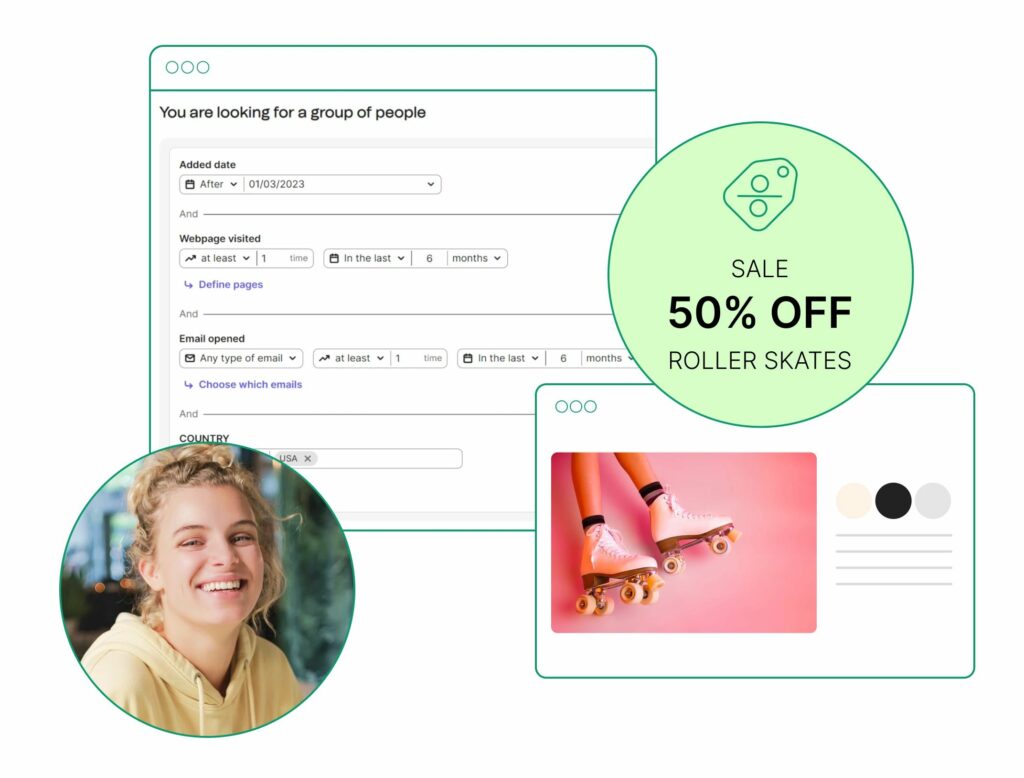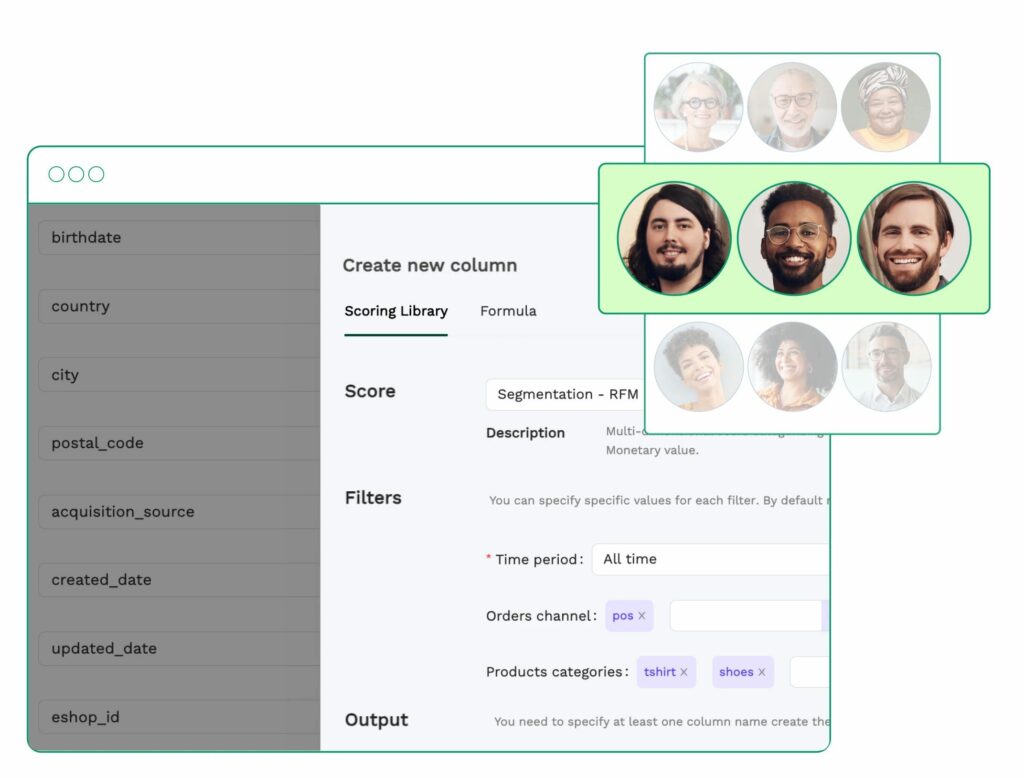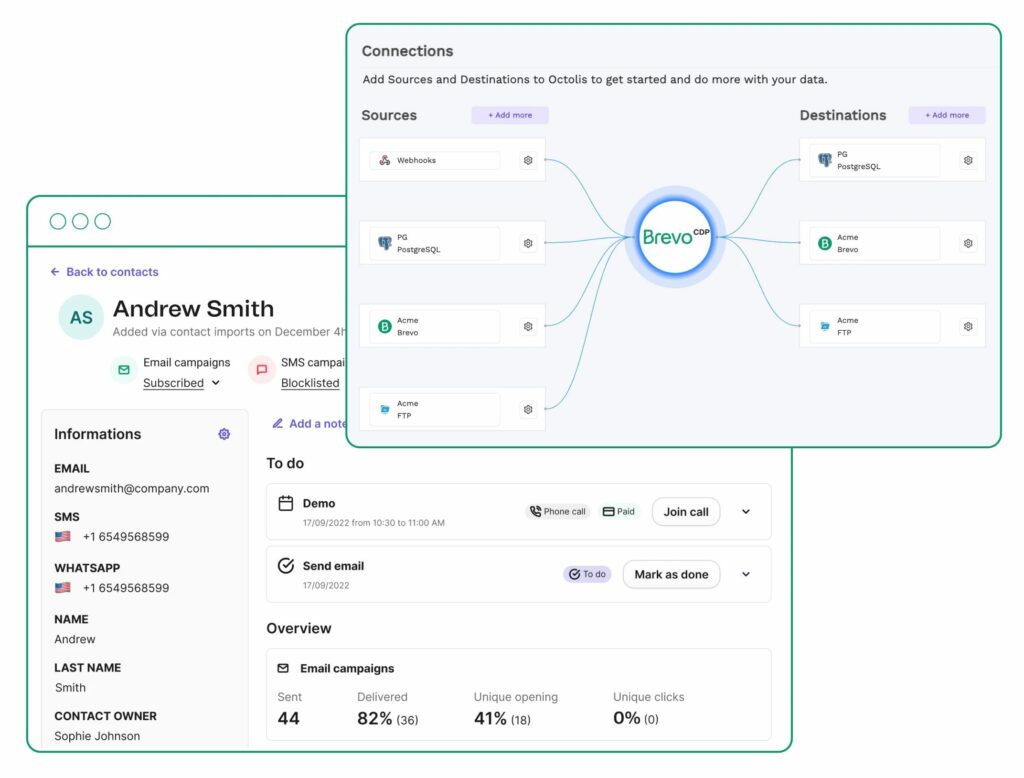Summary
Personalized and targeted email marketing campaigns are essential to drive conversions and maximize the value of every customer interaction.
To personalize effectively, businesses need high-quality customer data.
Brevo CDP offers a robust solution to unify, enrich, and sync customer data, empowering businesses to extract actionable insights and leverage smart segments to improve the customer journey.
In this article, we’ll go over pre-defined segments based on CDP scores and explore retail scenarios to illustrate how Brevo CDP enhances email marketing conversion.
Problem
Improving your email marketing performance isn't just about sending more emails. It's about sending smarter campaigns.
To achieve better conversion rates, marketers need to personalize their email marketing strategies with better targeting and optimized sending times.
According to a McKinsey survey, personalization can boost ROI by 10-30% (as well as lower acquisition costs and improve revenue). Sending emails aligned perfectly to the customer journey not only provides a better customer experience but also strengthens brand loyalty and improves LTV.
That's where Brevo CDP comes into play, offering a cutting-edge solution for understanding what customers need: Smart segments.
Understanding pre-defined segments
Brevo CDP offers pre-defined segments based on the scoring libraries, enabling businesses to categorize customers into specific groups with distinct behavioral patterns and purchasing tendencies. These pre-defined segments empower businesses to tailor their email marketing campaigns to resonate with each group, thereby increasing the likelihood of conversions.

For instance, using the RFM model, Brevo CDP can help you identify your "Top Customers," those “Needing Attention,” and the "At Risk" or "Lost" ones.
Similarly, Purchase Timing Deviation creates segments, such as "Recent Order", "On Track," and "Overdue," offering insights into your customers' purchasing cadence and enabling targeted interventions to re-engage or reward specific customer behaviors.
Let's explore some example scenarios based on Brevo CDP’s smart segments.
RFM segmentation: Optimize customer retention and LTV
The RFM (Recency, Frequency, Monetary) model enables businesses to categorize customers based on their transaction history, taking into account factors such as the recency of their last purchase, the frequency of purchases, and the monetary value of their transactions.
With this segmentation, Brevo allows businesses to identify top customers who have demonstrated consistent purchasing behavior, as well as customers who are at risk of churning or have already lapsed.
RFM marketing is a great way to increase customer retention, improve LTV, and maximize marketing ROI. Consider the following automation: your business has a large segment of “Promising customers.” They make high-value purchases but don’t buy often.
You decide to conduct a quick survey on this targeted segment to understand their preferences and recent experience with your brand. You ask them if the purchasing experience meets their expectations, if they like your product or service, and how often they prefer to make purchases — be it weekly, bi-weekly, monthly, or as needed. This tailored approach helps you gather insightful feedback directly from your customers, which you can then use in the upcoming strategies.

RFM score can be used in a diverse array of scenarios, be it engaging new contacts, converting first-time buyers to regulars, or giving a special referral code for top-spenders. By leveraging these segments, businesses can craft targeted email campaigns tailored to each group's specific needs and preferences, ultimately driving higher conversion rates.
Purchase timing segmentation: Increase repeat customers and satisfaction rate
Another valuable targeting offered by Brevo CDP is the Purchase Timing Deviation segmentation, which categorizes customers based on their adherence to typical purchasing patterns.
For example, customers who have recently made a purchase, those who are on track with their usual buying frequency, and those who have overdue purchases or have become inactive.
Let’s imagine the following scenario: you work in a company that sells coffee beans and you already gathered sufficient information to know that it takes, on average, 42 days for a second purchase to happen.
As a marketer, you could, of course, create an email campaign to remind users to place a new order every 5-6 weeks. However, that average doesn’t accurately represent your customers. Some people might order every 2 weeks, while others purchase once every 6 months.
This is where Purchase Timing Deviation score comes into play. Using this score, you can automate timely messages for each customer’s personal order frequency.
So now Tom, who likes his coffee beans to be freshly delivered once a month, can get a reminder 3 days in advance, while Amanda, who is less of a coffee drinker, will get her reminder in about 2 months.
And this segmentation is not only for simple reminders at an individual level. You can implement it in various marketing automations, such as personalized promotion emails for people “At risk”, or win-back emails for “Overdue” audiences, and much more.
Therefore, Purchase Timing Deviation segmentation provides businesses with valuable insights into the timing of customer transactions, enabling them to create targeted email marketing campaigns that nudge customers towards making a purchase or re-engaging with the brand.
Interested in seeing what Brevo CDP can do for your sales? Get in touch with our team.
Unleashing the power of smart segments for retail scenarios
Consider the challenge of incentivizing customers who only purchase in-store to start shopping online.
Data tells us that customers who shop both online and in-store tend to have a 30% higher Lifetime Value (LTV) than those who prefer only one channel. But how do we bridge the gap between these separate worlds, especially when data integration poses a significant challenge?
Brevo CDP's ability to unify, analyze, and score customer data across the tech stack makes this possible. It eliminates the silos between online and offline data, creating a unified customer profile that's accessible and actionable.
Example of email automation scenario: Eshop discount for in-store-only customers
Imagine sending an email to Sarah, who frequently shops in-store but has never made an online purchase. With Brevo CDP, you know Sarah's preferences, her in-store purchase history, and that she's yet to explore your online shop. You send Sarah a personalized email offering a special discount for her first online purchase, enticing her with exclusive online offers and convenience.
This targeted approach, made possible by Brevo CDP's Smart segments, not only enhances Sarah's shopping experience but also encourages her to become a more engaged, multi-channel customer.
Overcoming data integration challenges
A common hurdle in retail is knowing if Sarah is an in-store-only customer or if she has a digital profile as well.
This happens especially when online and offline data aren't merged. Many businesses struggle with managing scattered data, leading to missed opportunities. Leveraging customer data in marketing and sales strategies will be more difficult, if not impossible.
What we want is to ensure that when Sarah visits the online store or the physical shop, she’s identified consistently.
The best way to solve this problem is by integrating a Customer Data Platform (CDP), such as Brevo CDP, into your martech stack. CDPs function by centralizing and consolidating customer data from multiple sources like data warehouses, websites, customer engagement tools, and so on into a single profile.
Now, rather than having customer data scattered across spreadsheets, notes, emails, devices and so on, every piece of the puzzle is placed neatly together in the CDP. With accurate, consolidated data, businesses can identify more precise segments to leverage in future campaigns.
Brevo CDP provides a holistic view of the customer, regardless of the channel, ensuring no customer is left behind.

Conclusion
In today's data-driven marketing landscape, leveraging smart segments with Brevo CDP offers a clear path to improved email marketing conversion. By understanding and acting on the insightful details of customer behavior and preferences, businesses can design campaigns that are not just seen by but relevant to their customers.
Brevo’s ability to unify customer data with CDP, coupled with its dynamic segmentation and targeting capabilities in the CRM, empowers marketers to deliver personalized, timely, and compelling email content that drives engagement and conversion.
Embrace the power of Brevo and transform your email marketing strategy from generic messages to personalized conversations that resonate with each customer.






